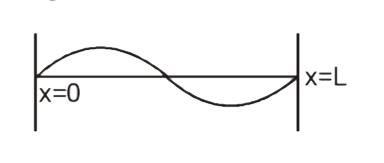The equation of standing wave of the second resonance can be
 ,
,
A
Pex=2Asin2π(y=1cm)cos2π9340)t
B
Pex=2Asin2π(y=1cm)cos2π9340)t
C
Pex=2Asin2π(y=1cm)cos2π9340)t
D
Pex=2Asin2π(y=1cm)cos2π9340)t
Text Solution
k=(2π0λ=2π1=2πω=2πf=(2π)(340)
first node will be formed at y=−1 instead of y=0 so eqn of standing wave is Pex=2Asin2π(y+1cm)cos2π(340)t .
|
Topper's Solved these Questions
- EXPERIMENTAL PHYSICSBOOK - RESONANCECHAPTER - EXPERIMENTAL PHYSICSEXERCISE - Exercise
12 Videos
- EXPERIMENTAL PHYSICSBOOK - RESONANCECHAPTER - EXPERIMENTAL PHYSICSEXERCISE - Exercise -1 PART
1 Videos
- ELECTROSTATICSBOOK - RESONANCECHAPTER - ELECTROSTATICSEXERCISE - HLP
39 Videos
- GEOMATRICAL OPTICS BOOK - RESONANCECHAPTER - GEOMATRICAL OPTICS EXERCISE - Advance level Problems
35 Videos
Similar Questions
Knowledge Check
In a standing wave on a string.
AIn one time period all the particles are simultaneously at rest twice.BAll the particles must be at their positive extremes simultaneously once in one time period.CAll the particles may be at their positive extremes simultaneously once in a time period.DAll the particles are never at rest simultaneously.A string of length l along x-axis is fixed at both ends and is vibrating in second harmonic. If at t=0, y=2.5mm for incident wave, the equation of standing wave is (T is tension and μ is linear density)
A(2.5mm)sin(2πlx)cos(2π√(Tμl2)t)B(5mm)sin(πlx)cos2πtC(5mm)sin(2πlx)cos(2π√(Tμl2)t)D(5mm)cos(2πlx)cos(2π√(Tμl2)t)

